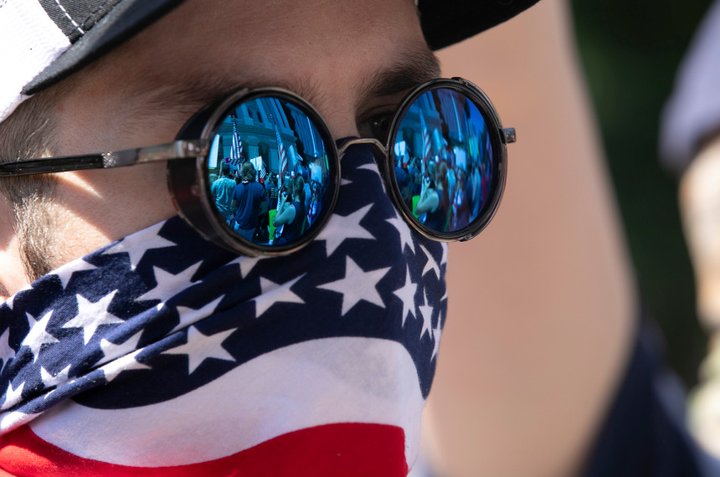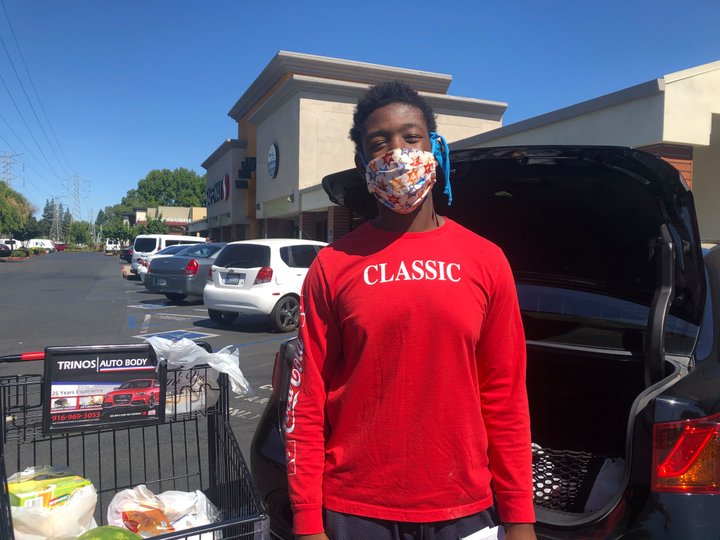
A protester covers his face with an American flag during a reopen California demonstration on May 1, 2020, in Sacramento. Photo by Anne Wernikoff for CalMatters
###
When hundreds gathered outside the state Capitol earlier this spring, demanding that Gov. Gavin Newsom reopen the state’s economy, some made clear they also had another message for him: You can’t make us wear a mask. One protester held a sign comparing face masks to dog muzzles, and many chanted and mingled without any type of face covering.
But after weeks of mixed messaging and leaving the decision of implementing mask mandates up to counties, the state today said face coverings will be required after all.
“Science shows that face coverings and masks work,” Newsom said in a statement. “They are critical to keeping those who are around you safe, keeping businesses open and restarting our economy.”
Newsom, who has preached localism on many coronavirus-related matters, has often explained that a one-size-fits-all approach doesn’t work in a state with 40 million people. But as the state reopens and coronavirus cases and hospitalizations climb in some parts, a statewide mask order can perhaps make a difference in controlling further spread, some public health and county officials have said.
Californians must now wear a face covering when interacting with other members of the public, and while in any indoor public space, as well as when in line to enter such spaces. These include pharmacies, a doctor’s office and the vet’s office. People must also wear a face covering while riding on public transportation, including a bus or a ride-share service, like Lyft or Uber.
The state’s new rules don’t require face masks for children under 2 and for people with a medical or developmental disability. People also don’t have to wear a mask during outdoor recreation, if they can keep six feet apart.
Prior to the state’s requirements, most Bay Area counties already had their own mandates. So did Los Angeles and San Diego. Some counties, including Riverside and San Bernardino, had temporary orders that were later lifted.
Meanwhile, many other counties stuck to a “strongly encourage” approach.
“Science shows that face coverings and masks work.”
— Gov. Gavin Newsom
Yet even with the new statewide order, there is almost certain to be continued public resistance and polarization. Across the state and country, arguments over masks have prompted brawls, threats and other violent acts. In one extreme case, a security guard at a Michigan Dollar Store was shot and killed after a dispute with a customer who refused to wear one.
But why?
Psychologists and public health experts point to a variety of reasons: Some people don’t like being told what to do, while some are skeptical about the science or confused by the mixed messaging.
For others, masks have become political.
Recently, Orange County became a battleground for face mask policy. This month, Dr. Nichole Quick resigned as the county health officer after receiving threats by people who opposed her mask mandate. Residents in opposition argued that the mask order was infringing on their rights to choose, while others said they weren’t persuaded by the science.
Two days after Quick’s resignation, the county’s new acting health officer changed the county’s mask guidelines from “must” to “should.”
Orange County Supervisor Don Wagner said he never understood why the mandate was ordered in the first place, calling it “a real perplexing situation.”
“I asked why, I didn’t say no — I couldn’t — but I asked her to explain it to the people of Orange County and to the board of supervisors,” he said. “Instead of getting that explanation, she left her post.”
That said, Wagner said he does wear his face covering when out in public. He lives in Irvine and his city required it before the state did. He also said he believes there is a benefit to masks.
“I do think there is something to the argument that it can, especially if you can’t physically distance, help slow the spread,” Wagner said. “I wear it when I’m in a store and if I am going to be passing people.”
The county’s clash of opinion was in full view this week when the Orange County Labor Confederation organized a press conference calling for a reinstatement of the mask order to protect essential workers. But the labor group was drowned out by anti-mask protestors, who showed up with a megaphone and signs that read “Show your smile” and “No masks.”
“Take your mask off, it’s not Halloween,” one woman shouted. “You look crazy!” yelled another.
One Placer County official said he will not be wearing a face covering, despite Newsom’s order.
“This has absolutely nothing to do with us reopening and it has 100% to do with the protests he allowed and encouraged,” Supervisor Kirk Uhler told CalMatters. He blames the jump in positive cases in his county on the Sacramento area protests following the police shooting death of George Floyd in Minneapolis.
But not all Californians who venture out without face coverings are ardent opponents.
In Sacramento, Wendy Valdez shopped at her local grocery store Wednesday, opting for no face covering. Her reasoning: it wasn’t required at the time. But if it were, she said, she’d wear it. “I just got my hair done and they required it, so I wore one,” she said.

Sinah Yovonie, 27, of Sacramento wears a mask while grocery shopping, but doesn’t think face coverings should be mandated. Ana B. Ibarra for CalMatters
Sinah Yovonie of Sacramento does wear a mask when grocery shopping. For him, it’s become a habit. But he doesn’t necessarily feel unsafe around those who aren’t wearing one, and he doesn’t like the idea of a mandate. “If you don’t want to spread it, you wear it, if you’re not bothered, you shouldn’t be forced.”
Dr. Susan Philip, a deputy health officer with the San Francisco Department of Public Health, said there is solid evidence that shows face coverings can help protect wearers from spreading the virus to others.
Sneezing, coughing and exhaling produces respiratory droplets, and a covering acts as a barrier that keeps these droplets from traveling.
San Francisco first issued its mask mandate in mid-April requiring coverings when entering an essential business or using public transportation. Officials then modified the order in late May to require that people wear coverings any time they left their homes.
“The thinking behind that is that as more of us start going out, we’re going to be around each other more and the face covering is one way to minimize the likelihood of transmission,” Philip said. “By having this in place for all of society we’re protecting each other.”
Because there are currently very few tools available to fight the spread of the virus, face coverings should be taken more seriously, some public health officials said even prior to the mandate.
Dr. Robert Wachter, professor and chair of the Department of Medicine at the University of California, San Francisco, said one of the reasons why mask wearing may have become so controversial is because of the messy, early messaging. For weeks after cases were first identified in the U.S., the CDC and state public health officials warned against face masks for the general public.
“In the very early days, people didn’t want to run out of masks, and that was not a ridiculous idea in March,” as shortages of protective equipment for health care workers became a top concern, he said. “But the messaging was too weak and inconsistent that some people took that to believe masks aren’t necessary.”
“Take your mask off, it’s not Halloween.”
— Orange county protester
Matthew Normand, a psychology professor at the University of the Pacific, explained that wearing face coverings is like wearing safety gear in the workplace.
“You have to do some very intentional things to promote safety behavior, like wearing safety equipment,” he said. Workers will sometimes go without their gear because they’re uncomfortable but also because any consequence of not wearing it is often delayed or improbable, Normand said.
So if people don’t see the immediate danger, they may be less motivated to take safety precautions, he said.
If people aren’t too concerned with safety, then they might be more influenced by social aspects — like whether people around them are wearing masks and what those people are saying about face coverings, Normand said. That’s in part why face coverings have become political, he said.
Newsom doesn’t make a public appearance without his mask (even if ill-fitting at times). In contrast, President Donald Trump is rarely ever seen wearing one and has ridiculed his Democratic opponent, Joe Biden, for wearing one.
“It also is really helpful when we see people who are in positions of authority modeling appropriate behavior, and I think we know we don’t see that much right now,” Normand said.
“There’s probably no more important podium than the president’s podium, and if he had a mask on and people were standing six feet away from him consistently, that could have a very strong influence at least on the people that support him.”
###
CALmatters.org is a nonprofit, nonpartisan media venture explaining California policies and politics.
CLICK TO MANAGE